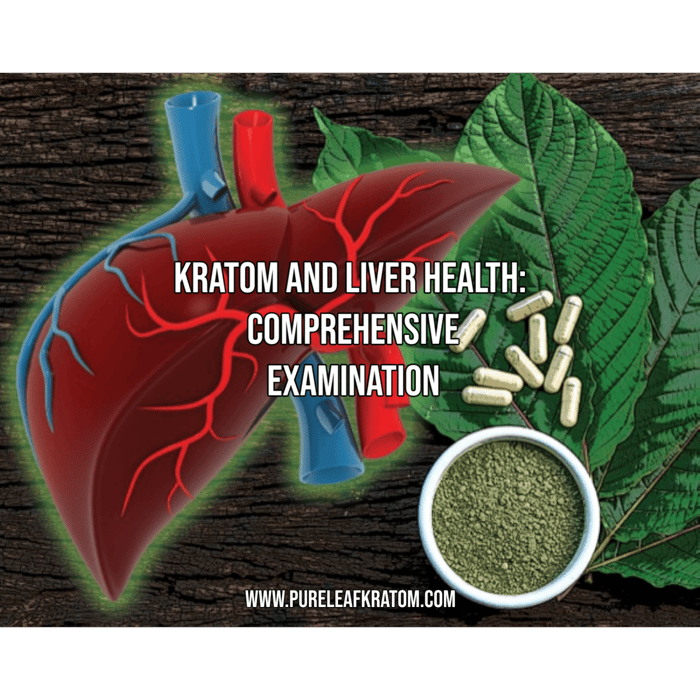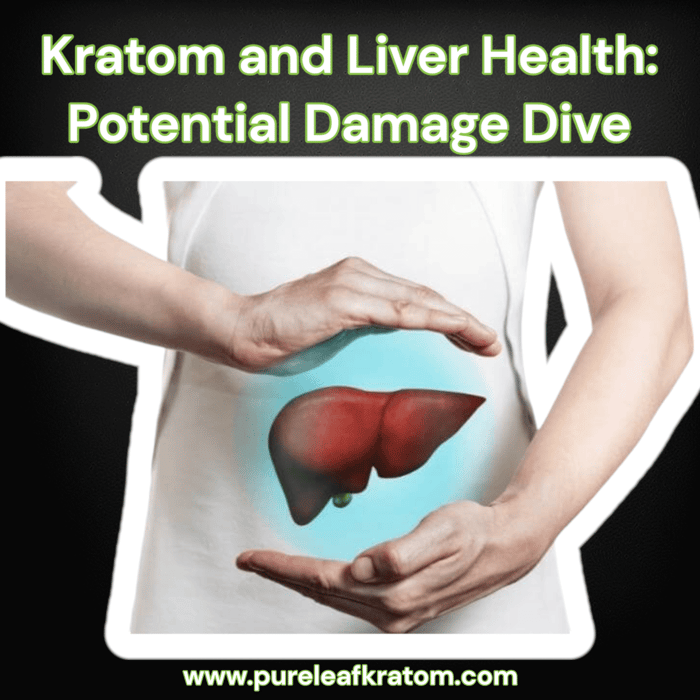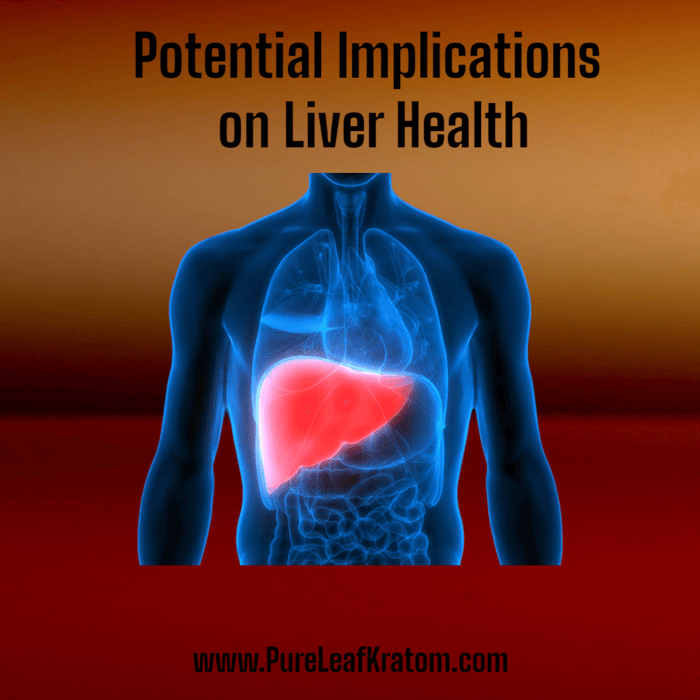
How Hard is Kratom on the Liver?: A Comprehensive Examination of Kratom's Impact on Liver Health
Unraveling the Enigma of Kratom: A Discovery of Intricacies
Recounting its roots back to Southeast Asia, Kratom, scientifically known as Mitragyna speciosa, has sparked significant intrigue and discord worldwide. Although it was traditionally employed in folk medicine as a stimulant and painkiller, its expanding presence in the sphere of recreational drugs and potential health implications has triggered a cascade of questions and concerns, particularly about its impact on liver health.
Dating Back To The Roots: Kratom's Native Origin and Uses
Derived from the tropical, evergreen tree species of Mitragyna in Southeast Asia, Kratom is a native herbal extract with psychoactive properties. Due to its inherent ability to induce sedative and euphoric sensations, Kratom has been used for centuries in its homeland for medicinal purposes. It functioned as a natural remedy for various ailments, ranging from coughs and fatigue to depression and chronic pain.
Straddling The Bounds Of Legality: The Controversy Surrounding Kratom
Despite its traditional medicinal utility, Kratom has been rather enigmatic in legal terms. As per current legal status, usage of Kratom is banned in numerous countries like Australia, Denmark, Finland and Malaysia, among others. In the United States, legality varies considerably among states, with six states outlawing the extract. However, a majority of the states either place certain restrictions or allow its consumption with users alerted to potential risks.
Notwithstanding its controversial legal status, Kratom thrives on the internet market, positioned as an opioid alternative. The tug-of-war between regulators, who regard Kratom as a hazardous opioid, and advocates, who view it as a therapeutic traditional medicine, underpins the ongoing contention surrounding Kratom legality. Consequently, rules are often ambiguous, with some countries necessitating prescriptions and others having hazy laws, like China and several African nations.
Tusk Platinum Ultra Premium Kratom Powder Peach 200mg

$9.95
Tusk Platinum Ultra Premium Kratom Powder Peach 200mg In the realm of botanical wonders, Pure Leaf Kratom proudly presents the Tusk Platinum Ultra Premium Kratom...… read more
The Gambling Act: High-Dosage Implications And Potential Liver Risks
While Kratom might promise some beneficial health effects, it's critical to remark that its use is not without risks. Chiefly among these are the potential for addiction, dependence, and overdose, particularly with unregulated online sales. But to further cloud this intricate scenario, is the potential onset of liver damage due to consistent high-dose Kratom usage. Markedly ominous symptoms, including seizures and coma, have been observed, hinting at the darker underbelly of habitual Kratom consumption.
The primary concern, however, lies with Kratom's proposed link to hepatotoxicity, causing liver injury— an issue that demands comprehensive analysis. The forthcoming sections will dive deep into this subject, investigating the effects of Kratom on liver health and the potential perils of persistent, oblivious use.
Given its potential for causing harm to the liver, understanding the science behind Kratom and its effects is crucially important. First, let's get a grip on some of the key terms needed to explore this issue. "Hepatotoxicity" refers to the ability of a substance to cause liver damage. This damage often results in liver injuries that are described as "cholestatic" or "mixed." A cholestatic liver injury pertains to the disturbance or blockage of bile flow, leading to liver cell damage and inflammation.
Turning our attention to the connection between Kratom usage and serum bilirubin levels, we explore how Kratom interacts with the liver. An increase in these levels often signifies liver disease or damage, as bilirubin is usually processed and eliminated by the liver. When the liver gets affected, it can result in a buildup of bilirubin, resulting in jaundice, which is characterized by yellowing of the skin and eyes.
To fully understand the impact of Kratom on the liver, it is vital to shape our knowledge via case reports and studies that document Kratom-induced liver damage. Citing cases of acute liver injury resulting from regular usage of Kratom, a comprehensive review describes liver injury as having a cholestatic pattern with symptoms including abdominal discomfort, jaundice, itching, and dark urine. The median onset is around three weeks after starting Kratom use. Although these injuries can be severe, requiring transplants in some instances, they are often reversible upon cessation of Kratom use.
Lastly, let's dig a little deeper into the pharmacology of Kratom and its potential for hepatotoxic effects. While the exact mechanism by which Kratom induces hepatotoxicity remains unclear, proposed theories suggest either a direct toxicity effect on the liver or an interference with metabolic enzymes and transporters in the liver which process the compound. These theories hint at the possible predicaments and complexities involved in discerning the exact nature of Kratom's impact on the liver, warranting further research in the field.
In familiarizing yourself with Kratom, it's crucial to understand the timeline and severity of potential liver issues. Typical symptoms, like jaundice and fatigue, often reveal themselves after several weeks of Kratom usage. This series of events is backed up by medical literature, which documents a median latency period of about 21 days before symptom onset. Along with discomfort in the abdomen, dark urine, and itching, jaundice prominently features among the common initial symptoms.
While these symptoms might seem manageable, continuous use or high dosage of Kratom could usher in severe Liver health issues. Cirrhosis, fibrosis, and liver cancer are all potential risks stemming from liver damage. Even with this knowledge, one must bear in mind that while Kratom effects on the liver are not well understood, the occurrence of these severe conditions is considered rare but significant. What's clear though, is that the severity of these conditions requires immediate attention. Cases of Kratom-induced liver injury predominantly present cholestatic or mixed patterns, meaning that the injury could affect either the inflow of bile into the liver, its outflow from the liver, or both.
K Tropix Kratom Enhanced Nootropic Shot

$12.69
K Tropix Kratom Enhanced Nootropic Shot The K Tropix Kratom Enhanced Nootropic Shot seamlessly combines the purest kratom with potent neuroenhancers, creating a one-of-a-kind nootropic...… read more
Delving into Case Studies of Kratom Induced Liver Damage
When it comes to tracing the impact of Kratom on liver health, several case studies and reports do raise alarm bells. For instance, one report associates Kratom with acute liver injury and failure in six patients. This serious risk cannot be brushed aside, especially considering the lack of regulation and quality control in commercial Kratom preparations. While further research is needed to pinpoint dose-dependent liver effects, the evidence available links both Kratom use and withdrawal with a higher risk of acute liver injury.
Long-Term Effects on Liver health Function
Despite the rarity of severe liver complications in relation to overall Kratom usage, it goes without saying, your liver health is a vital part of your body's health. Chronic use of Kratom may lead to persistent cholestasis, even after discontinuing. Long term implications of Kratom use on liver function are yet to be fully understood. The scientific community, while aware of the potential risks, remains keen to unpack the underlying mechanisms behind Kratom induced hepatotoxicity.
Club 13 Kratom Extract Gummies Variety Pack Squares

$20.89
Club 13 Kratom Extract Gummies Variety Pack Squares Introducing our Club 13 Kratom Extract Gummies Variety Pack Squares, a delightful and convenient way to incorporate...… read more
Assessing the Acuteness of Liver Issues Due to Kratom Usage
Never too far out of sight are acute liver issues related to Kratom use. While these are considered rare, their severity cannot be underestimated. Many of the documented cases reported link between Kratom usage and elevated bilirubin levels, often accompanied by high ALT (Alanine Aminotransferase) and Alkaline Phosphatase, all suggestive of possible liver injury. What's interesting is that, in majority of these cases, the LiverTox records show that the liver injury had typically arisen within a period of 1 to 8 weeks after initiating Kratom use. The underlying mechanism of liver injury remains an enigma, although theories propose a direct toxin-mediated effect. Nonetheless, discontinuing Kratom seems to be the most common denominator towards managing these conditions.
Summing up, it's evident that Kratom can be severe on liver health, often exhibiting hepatotoxicity. The actual incidence rate and risk factors are still clouded with uncertainty. Yet, understanding its impact on liver health, particularly on the onset of symptoms, the potential severity, and how to manage these conditions is key. With Kratom, as with many substances, moderation and safety are of utmost importance.
When discussing Kratom use and its potential effects on the liver, it's essential to understand the importance of recognizing early symptoms of potential liver injury. Manifestations such as fatigue, nausea, abdominal pain, and jaundice may indicate elevated liver enzymes, commonly seen in cases of Kratom-induced liver damage. Noticing these symptoms early and subsequently stopping Kratom use is typically synonymous with improvement in a user's condition.
Yet, it's important to keep in mind that issues like persistent cholestasis might still surface even after Kratom ingestion ceases. Cholestasis is a condition involving the impairment or blockage of bile flow, which can lead to hepatitis, cirrhosis, and other serious complications if not checked.
Interestingly, there are a multitude of case reports that document the resolution of liver issues after discontinuing Kratom. This often involves a normalization of liver enzymes over time, allowing the liver to regain its normal function. However, it's important to note that while discontinuation of Kratom generally leads to improvement, causality cannot be outrightly established due to confounding factors like pre-existing liver conditions or concurrent use of other drugs.
When considering discontinuing Kratom use due to liver health, it is always advisable to involve professionals. Consultation with healthcare practitioners can help bring clarity to your decision and offer personalized guidance. Follow-up treatments and therapies may then be advised accordingly, to ensure swift and proper recovery post-Kratom use.
While more research on this topic is needed, it's clear that discontinuing Kratom has been beneficial for those suffering from potential Kratom-induced liver injury. One should be wary of the dangers and symptoms associated with this very real but rarely discussed side effect of Kratom's consumption. Whether choosing to continue or discontinue Kratom, continuous monitoring of any physiological changes that may occur is paramount.
Unraveling the nuances of Kratom's potential implications on liver health seems like threading through a labyrinth. While chronic, high-dose use has been definitively linked to liver injury, there's still a significant grey area surrounding the cause-and-effect relationships, as well as the identification of tangible risk factors. The typical presentation of Kratom-induced liver injury is either cholestatic, involving the obstruction of bile flow, or a mixed pattern of injury, often occurring between 1-8 weeks of Kratom use. However, the mechanism of this injury remains shrouded in uncertainty.
Adding to the murkiness, the prevalence of Kratom hepatotoxicity appears quite low when compared to the overall number of Kratom users, further complicating research in this field. As a result, practical and effective treatments for Kratom-induced liver damage are scarce and predominantly rely on anecdotal evidence stemming from a limited number of case scenarios. In some instances, corticosteroids and N-acetylcysteine, a medication used for acetaminophen overdose and to thin mucus in the airways in people with certain lung diseases, have been tried, but their efficacy remains largely unproven. Nonetheless, the dominant and generally successful approach in resolving cases of liver injury has been to discontinue Kratom use, often leading to slow but steady improvements over a span of weeks.
Given this ambiguity, it's clear that gaps proliferate in the current understanding of Kratom's potential impact on liver health, creating an evident void in research on the topic. The key area of concern lies within the intricacies of liver injuries caused by Kratom’s interactions with other substances. As noted in several case reports, significant liver injuries have resulted from a probable interplay between Kratom and certain medications, particularly those metabolized by the CYP3A4 enzyme. This finding underscores the necessity for preventative measures that focus on limiting such damaging interactions.
Despite a paucity of concrete studies on treating Kratom hepatotoxicity, medical practitioners have been able to manage these cases through conservative approaches, strengthening the need for further research and controlled trials on this subject. As such, advancements in the identification and understanding of specific risk factors could prove instrumental in preventing and effectively treating Kratom-induced liver injuries, while aiding in bridging the existing knowledge gaps.




